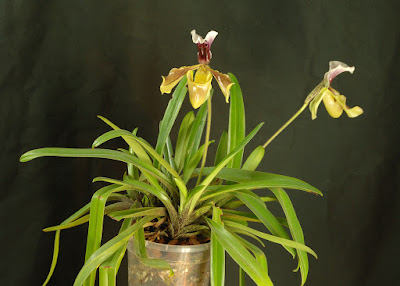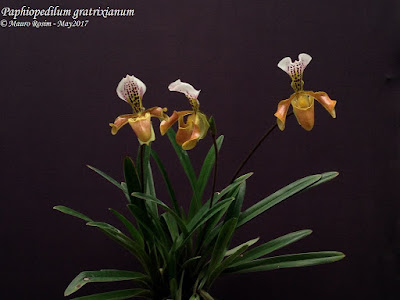Paphiopedilum gratrixianum is found in very few disjunctive localities along the Viet Nam-Lao PDR border, along the Lao PDR and Thailand border and in southern China. It grows in primary, broad-leaved, evergreen highland cloud forests, closed forests, shady cliffs and steep mountain slopes at 900 to 1220 meters.
Paphiopedilum gratrixianum also called as Gratix's Paphiopedilum, Cordula gratrixiana, Cypripedium gratrixianum, Cypripedium gratrixianum, Paphiopedilum gratrixianum var. daoense, Paphiopedilum villosum var gratixianum, Paphiopedilum gratrixianum var. cangyuanense, is a species of the genus Paphiopedilum. This species was described by Robert Allen Rolfe in 1905.
IDENTIFY PAPHIOPEDILUM GRATRIXIANUM ORCHID PLANT
Paphiopedilum gratrixianum is found in very few disjunctive localities along the Viet Nam-Lao PDR border, along the Lao PDR and Thailand border and in southern China. It grows in primary, broad-leaved, evergreen highland cloud forests, closed forests, shady cliffs and steep mountain slopes at 900 to 1220 meters.
It is a small sized, warm to cool growing, clump forming, litho-terrestrial in deep shade with distichous, solid green, suberect, linear to lanceolate and oblong, up to 30 cm long, 2-4 cm wide leaves with an acute or minutely tridentate apices that are purple spotted below towards the leaf base.
Gratix's Paphiopedilum blooms in the fall and early winter on a erect, to 25 cm long, single flowered, green with purple pubescence inflorescence with a narrowly oblong-lanceolate to obovate, acute to obtuse floral bract carrying a long-lasting flower.
PAPHIOPEDILUM GRATRIXIANUM ORCHID PLANT CARE AND CULTURE
Cultural information should only be used as a guide, and should be to be adapted to suit you. Your physical location; where you grow your plants, how much time you have to devote to their care, and many other factors, will need to be taken into account. Only then can you decide on the cultural methods that best suit you and your plants.
Light:
Paphiopedilum gratrixianum like bright sunshine without access to direct sunlight, so during the midday solstice they must be placed behind a curtain or in the shade of other plants.
Temperature:
This orchid need the follow temperature regime: In summer, the day temperature at 20-22 ° C, and night temperature at 17-19 ° C; in winter the day temperature at 20-23 ° C, and night temperature at 13-16 ° C. For successful cultivation at home, the night temperature of the content should always be 3 ° C lower than the daily one.
Humidity:
The humidity of 50-70% will be enough for normal growth and development of the plant. However, at temperatures above 27 ° C, it is desirable to increase the air humidity to at least 70%, since too dry air adversely affects the roots and leaves of the plant. A lot of fresh air and sufficient air circulation are recommended.
Substrate, growing media and repotting:
Paphiopedilum gratrixianum are grow only in the pot. A mixture of bark of coniferous trees with peat is best suited as a substrate. In addition, it is strongly recommended to add lime to the substrate. Practically not exhausted source of lime are seashells, which can be thoroughly washed from salt, crushed and poured into the substrate.
Repot is necessary annually. The best time for this is spring - the beginning of a new growth. A very important point here is the height of planting. If this orchid is planted incorrectly, for example, too high, the orchid's roots will hang in the air and stop growing. The substrate should cover the upper red-and-white part of the plant for 1-2 fingers, and in no case should it be tamped down, because if the substrate is too dense, the orchid can simply suffocate. When planting, you must take care of a thick layer of drainage to protect the orchid from stagnant water inside the pot.
Watering:
Gratix's Paphiopedilum needs frequent and abundant watering throughout the year. Excess water during irrigation should flow freely from the pot, since stagnation of water both inside the pot and in its pan can very quickly lead to rotting of the roots and the lower part of the plant. The substrate between waterings should dry well, but not dry completely. After watering, water from the leaves must be removed with a tissue or tissue.
Spraying the outer part of the plant at home will not lead to anything good, since the structure of its leaves resembles a funnel, and water constantly accumulates in the core of the plant, which can very quickly lead to rotting of both peduncles and the core itself.
Fertilizer:
Throughout the year, this orchid is fertilized once every two weeks in the spring and summer, once every 4 weeks in the fall and winter. Fertilizer should be applied to the plant with 30-10-10 fertilizer, diluted, ¼ teaspoon per week in summer and once a month in winter. Each month to flush the water once to prevent the salt from standing in the pot.
Rest period:
Paphiopedilum gratrixianum does not need a rest period to stimulating flowering nor in winter, so the given condition should maintain throughout the year.















COMMENTS